Sustainability and Open Innovation: Main Themes and Research Trajectories
Abstract
:1. Introduction
2. Theoretical Background
2.1. Sustainable Innovation
2.2. Open Innovation
2.3. Sustainable Open Innovation
3. Research Methodology
3.1. Data Collection
- -
- Only articles, reviews and conference papers were retained in order to ensure the reliability of the sources;
- -
- Only those contributions published in peer-reviewed scientific articles were considered;
- -
- Only contributions in English were considered.
3.2. Bibliometric Analysis
Co-Occurrence Analysis
4. Findings
4.1. Descriptive Statistics
4.2. Thematic Areas of Research
4.2.1. Sustainable Open Innovation and Innovation Performance
4.2.2. The Role of Technological Capability for Sustainable Open Innovation
4.2.3. Business Model Perspective
4.2.4. Sustainable Open Innovation and University Collaboration
4.3. Future Research Avenues
Open Sustainable Innovation in the Agri-Food Industry
5. Discussion
5.1. Comparison with Previous Literature Reviews
5.2. Managerial Implications
6. Conclusions and Limitations
Author Contributions
Funding
Institutional Review Board Statement
Informed Consent Statement
Data Availability Statement
Conflicts of Interest
References
- Cillo, V.; Petruzzelli, A.M.; Ardito, L.; Del Giudice, M. Understanding Sustainable Innovation: A Systematic Literature Review. Corp. Soc. Responsib. Environ. Manag. 2019, 26, 1012–1025. [Google Scholar] [CrossRef]
- Clark, T.; Charter, M. Sustainable Innovation: Key Conclusions from Sustainable Innovation Conferences 2003–2006 Organised by the Centre for Sustainable Design; The Centre for Sustainable Design: Farnham, UK, 2007. [Google Scholar]
- De Marchi, V.; Grandinetti, R. Knowledge Strategies for Environmental Innovations: The Case of Italian Manufacturing Firms. J. Knowl. Manag. 2013, 17, 569–582. [Google Scholar] [CrossRef]
- Bigliardi, B.; Filippelli, S.; Galati, F. Sustainable Innovation: Drivers, Barriers, and Actors under an Open Innovation Lens. In Sustainable Innovation; Routledge: Oxfordshire, UK, 2021; pp. 109–122. ISBN 0-429-29950-8. [Google Scholar]
- Sanni, M.; Verdolini, E. Eco-Innovation and Openness: Mapping the Growth Trajectories and the Knowledge Structure of Open Eco-Innovation. Sustain. Futures 2022, 4, 100067. [Google Scholar] [CrossRef]
- Chistov, V.; Aramburu, N.; Carrillo-Hermosilla, J. Open Eco-Innovation: A Bibliometric Review of Emerging Research. J. Clean. Prod. 2021, 311, 127627. [Google Scholar] [CrossRef]
- Rauter, R.; Perl-Vorbach, E.; Baumgartner, R.J. Is Open Innovation Supporting Sustainable Innovation? Findings Based on a Systematic, Explorative Analysis of Existing Literature. Int. J. Innov. Sustain. Dev. 2017, 11, 249–270. [Google Scholar] [CrossRef]
- Pontieri, P.; Mennini, F.S.; Magni, D.; Fiano, F.; Scuotto, V.; Papa, A.; Aletta, M.; Del Giudice, L. Sustainable Open Innovation for the Agri-Food System: Sorghum as Healthy Food to Deal with Environmental Challenges. Br. Food J. 2021. [Google Scholar] [CrossRef]
- Nielsen, K.R.; Reisch, L.A.; Thøgersen, J. Sustainable User Innovation from a Policy Perspective: A Systematic Literature Review. J. Clean. Prod. 2016, 133, 65–77. [Google Scholar] [CrossRef] [Green Version]
- Kemp, R. Eco-Innovation: Definition, Measurement and Open Research Issues. Econ. Politica 2010, 27, 397–420. [Google Scholar]
- Takalo, S.K.; Tooranloo, H.S. Green Innovation: A Systematic Literature Review. J. Clean. Prod. 2021, 279, 122474. [Google Scholar] [CrossRef]
- Carrión-Flores, C.E.; Innes, R. Environmental Innovation and Environmental Performance. J. Environ. Econ. Manag. 2010, 59, 27–42. [Google Scholar] [CrossRef]
- Adams, R.; Jeanrenaud, S.; Bessant, J.; Denyer, D.; Overy, P. Sustainability-oriented Innovation: A Systematic Review. Int. J. Manag. Rev. 2016, 18, 180–205. [Google Scholar] [CrossRef]
- Vollenbroek, F.A. Sustainable Development and the Challenge of Innovation. J. Clean. Prod. 2002, 10, 215–223. [Google Scholar] [CrossRef]
- Chesbrough, H.; Vanhaverbeke, W.; West, J. Open Innovation. New Imp. Creat. Profit. Technol. 2006, 1, 285–307. [Google Scholar]
- Chesbrough, H. Open Innovation: Where We’ve Been and Where We’re Going. Res.-Technol. Manag. 2012, 55, 20–27. [Google Scholar] [CrossRef]
- Naqshbandi, M.M.; Jasimuddin, S.M. The Linkage between Open Innovation, Absorptive Capacity and Managerial Ties: A Cross-Country Perspective. J. Innov. Knowl. 2022, 7, 100167. [Google Scholar] [CrossRef]
- Lee, S.; Park, G.; Yoon, B.; Park, J. Open Innovation in SMEs—An Intermediated Network Model. Res. Policy 2010, 39, 290–300. [Google Scholar] [CrossRef]
- Hossain, M. A Review of Literature on Open Innovation in Small and Medium-Sized Enterprises. J. Glob. Entrep. Res. 2015, 5, 1–12. [Google Scholar] [CrossRef] [Green Version]
- Hossain, M.; Kauranen, I. Open Innovation in SMEs: A Systematic Literature Review. J. Strategy Manag. 2016. [Google Scholar] [CrossRef]
- Van de Vrande, V.; De Jong, J.P.; Vanhaverbeke, W.; De Rochemont, M. Open Innovation in SMEs: Trends, Motives and Management Challenges. Technovation 2009, 29, 423–437. [Google Scholar] [CrossRef] [Green Version]
- Rangus, K.; Drnovšek, M. Open Innovation in Slovenia: A Comparative Analysis of Different Firm Sizes. Econ. Bus. Rev. 2013, 15, 1. [Google Scholar] [CrossRef]
- Venturelli, A.; Caputo, A.; Pizzi, S.; Valenza, G. A Dynamic Framework for Sustainable Open Innovation in the Food Industry. Br. Food J. 2022. [Google Scholar] [CrossRef]
- Brown, P.; Bocken, N.; Balkenende, R. How Do Companies Collaborate for Circular Oriented Innovation? Sustainability 2020, 12, 1648. [Google Scholar] [CrossRef] [Green Version]
- Rialti, R.; Marrucci, A.; Zollo, L.; Ciappei, C. Digital Technologies, Sustainable Open Innovation and Shared Value Creation: Evidence from an Italian Agritech Business. Br. Food J. 2022. [Google Scholar] [CrossRef]
- Marchiori, D.M.; Popadiuk, S.; Mainardes, E.W.; Rodrigues, R.G. Innovativeness: A Bibliometric Vision of the Conceptual and Intellectual Structures and the Past and Future Research Directions. Scientometrics 2021, 126, 55–92. [Google Scholar] [CrossRef]
- Bosman, J.; van Mourik, I.; Rasch, M.; Sieverts, E.; Verhoeff, H. Scopus Reviewed and Compared: The Coverage and Functionality of the Citation Database Scopus, Including Comparisons with Web of Science and Google Scholar; Utrecht University Library: Utrecht, The Netherlands, 2006. [Google Scholar]
- Beliaeva, T.; Ferasso, M.; Kraus, S.; Mahto, R.V. Marketing and Family Firms: Theoretical Roots, Research Trajectories, and Themes. J. Bus. Res. 2022, 144, 66–79. [Google Scholar] [CrossRef]
- Ding, X.; Yang, Z. Knowledge Mapping of Platform Research: A Visual Analysis Using VOSviewer and CiteSpace. Electron. Commer. Res. 2020, 1–23. [Google Scholar] [CrossRef]
- He, Q. Knowledge Discovery through Co-Word Analysis. Libr. Trends 1999, 48, 133–159. [Google Scholar]
- Van Eck, N.; Waltman, L. Software Survey: VOSviewer, a Computer Program for Bibliometric Mapping. Scientometrics 2010, 84, 523–538. [Google Scholar] [CrossRef] [Green Version]
- Lopez-Vega, H.; Lakemond, N. Tapping into Emerging Markets: EMNEs’ Strategies for Innovation Capability Building. Glob. Strategy J. 2022, 12, 394–417. [Google Scholar] [CrossRef]
- Ghassim, B.; Foss, L. Understanding the Micro-Foundations of Internal Capabilities for Open Innovation in the Minerals Industry: A Holistic Sustainability Perspective. Resour. Policy 2018, 74, 101271. [Google Scholar] [CrossRef]
- Meidute-Kavaliauskiene, I.; Çiğdem, Ş.; Vasilis Vasiliauskas, A.; Yıldız, B. Green Innovation in Environmental Complexity: The Implication of Open Innovation. J. Open Innov. Technol. Mark. Complex. 2021, 7, 107. [Google Scholar] [CrossRef]
- Gyamfi, S.; Sein, Y.Y. Determinants of Sustainable Open Innovations—A Firm-Level Capacity Analysis. Sustainability 2021, 13, 9088. [Google Scholar] [CrossRef]
- Ghassim, B.; Bogers, M. Linking Stakeholder Engagement to Profitability through Sustainability-Oriented Innovation: A Quantitative Study of the Minerals Industry. J. Clean. Prod. 2019, 224, 905–919. [Google Scholar] [CrossRef]
- Roszkowska-Menkes, M.T. Integrating Strategic CSR and Open Innovation. Towards a Conceptual Framework. Soc. Responsib. J. 2018, 14, 950–966. [Google Scholar] [CrossRef]
- Füller, J.; Hutter, K.; Kröger, N. Crowdsourcing as a Service–from Pilot Projects to Sustainable Innovation Routines. Int. J. Proj. Manag. 2021, 39, 183–195. [Google Scholar] [CrossRef]
- Costa, J.; Matias, J.C. Open Innovation 4.0 as an Enhancer of Sustainable Innovation Ecosystems. Sustainability 2020, 12, 8112. [Google Scholar] [CrossRef]
- Medina-Salgado, M.S.; García-Muiña, F.E.; Cucchi, M.; Settembre-Blundo, D. Adaptive Life Cycle Costing (LCC) Modeling and Applying to Italy Ceramic Tile Manufacturing Sector: Its Implication of Open Innovation. J. Open Innov. Technol. Mark. Complex. 2021, 7, 101. [Google Scholar] [CrossRef]
- Krmela, A.; Šimberová, I.; Babiča, V. Dynamics of Business Models in Industry-Wide Collaborative Networks for Circularity. J. Open Innov. Technol. Mark. Complex. 2022, 8, 3. [Google Scholar] [CrossRef]
- Soorige, D.; Karunasena, G.; Kulatunga, U.; Mahmood, M.N.; De Silva, L. An Energy Culture Maturity Conceptual Framework on Adopting Energy-Efficient Technology Innovations in Buildings. J. Open Innov. Technol. Mark. Complex. 2022, 8, 60. [Google Scholar] [CrossRef]
- Khurana, S.; Haleem, A.; Mannan, B. Determinants for Integration of Sustainability with Innovation for Indian Manufacturing Enterprises: Empirical Evidence in MSMEs. J. Clean. Prod. 2019, 229, 374–386. [Google Scholar] [CrossRef]
- Kimpimäki, J.-P.; Malacina, I.; Lähdeaho, O. Open and Sustainable: An Emerging Frontier in Innovation Management? Technol. Forecast. Soc. Chang. 2022, 174, 121229. [Google Scholar] [CrossRef]
- Fernández, S.; Torrecillas, C.; Labra, R.E. Drivers of Eco-Innovation in Developing Countries: The Case of Chilean Firms. Technol. Forecast. Soc. Chang. 2021, 170, 120902. [Google Scholar] [CrossRef]
- Manion, M.T.; Cherion, J. Impact of Strategic Type on Success Measures for Product Development Projects. J. Prod. Innov. Manag. 2009, 26, 71–85. [Google Scholar] [CrossRef]
- Schöggl, J.-P.; Baumgartner, R.J.; Hofer, D. Improving Sustainability Performance in Early Phases of Product Design: A Checklist for Sustainable Product Development Tested in the Automotive Industry. J. Clean. Prod. 2017, 140, 1602–1617. [Google Scholar] [CrossRef]
- Peteraf, M.A. The Cornerstones of Competitive Advantage: A Resource-based View. Strateg. Manag. J. 1993, 14, 179–191. [Google Scholar] [CrossRef]
- Coombs, J.E.; Bierly III, P.E. Measuring Technological Capability and Performance. RD Manag. 2006, 36, 421–438. [Google Scholar] [CrossRef]
- Tsai, K.-H. The Impact of Technological Capability on Firm Performance in Taiwan’s Electronics Industry. J. High Technol. Manag. Res. 2004, 15, 183–195. [Google Scholar] [CrossRef]
- Behnam, S.; Cagliano, R.; Grijalvo, M. How Should Firms Reconcile Their Open Innovation Capabilities for Incorporating External Actors in Innovations Aimed at Sustainable Development? J. Clean. Prod. 2018, 170, 950–965. [Google Scholar] [CrossRef] [Green Version]
- Teece, D.J. Business Models and Dynamic Capabilities. Long Range Plan. 2018, 51, 40–49. [Google Scholar] [CrossRef]
- Kietzmann, J.H. Crowdsourcing: A Revised Definition and Introduction to New Research. Bus. Horiz. 2017, 60, 151–153. [Google Scholar] [CrossRef]
- Eisenreich, A.; Füller, J.; Stuchtey, M. Open Circular Innovation: How Companies Can Develop Circular Innovations in Collaboration with Stakeholders. Sustainability 2021, 13, 13456. [Google Scholar] [CrossRef]
- Massa, L.; Tucci, C.L. Business Model Innovation. Oxf. Handb. Innov. Manag. 2013, 20, 420–441. [Google Scholar]
- Schaltegger, S.; Lüdeke-Freund, F.; Hansen, E.G. Business Cases for Sustainability and the Role of Business Model Innovation: Developing a Conceptual Framework. Cent. Sustain. Manag. 2011. Available online: https://www.researchgate.net/publication/256013058_Business_Cases_for_Sustainability_and_the_Role_of_Business_Model_Innovation_Developing_a_Conceptual_Framework (accessed on 17 April 2022).
- Evans, S.; Vladimirova, D.; Holgado, M.; Van Fossen, K.; Yang, M.; Silva, E.A.; Barlow, C.Y. Business Model Innovation for Sustainability: Towards a Unified Perspective for Creation of Sustainable Business Models. Bus. Strategy Environ. 2017, 26, 597–608. [Google Scholar] [CrossRef]
- Lüdeke-Freund, F.; Dembek, K. Sustainable Business Model Research and Practice: Emerging Field or Passing Fancy? J. Clean. Prod. 2017, 168, 1668–1678. [Google Scholar] [CrossRef]
- Schaltegger, S.; Hansen, E.G.; Lüdeke-Freund, F. Business Models for Sustainability: Origins, Present Research, and Future Avenues; Sage Publications: Los Angeles, CA, USA, 2016; pp. 3–10. ISBN 1086-0266. [Google Scholar]
- Bigliardi, B.; Filippelli, S. Investigating Circular Business Model Innovation through Keywords Analysis. Sustainability 2021, 13, 5036. [Google Scholar] [CrossRef]
- Huang, H.-C.; Lai, M.-C.; Lin, L.-H.; Chen, C.-T. Overcoming Organizational Inertia to Strengthen Business Model Innovation: An Open Innovation Perspective. J. Organ. Chang. Manag. 2013. [Google Scholar] [CrossRef]
- Kobarg, S.; Stumpf-Wollersheim, J.; Schlägel, C.; Welpe, I.M. Green Together? The Effects of Companies’ Innovation Collaboration with Different Partner Types on Ecological Process and Product Innovation. Ind. Innov. 2020, 27, 953–990. [Google Scholar] [CrossRef]
- Nieto, M.J.; Santamaría, L. The Importance of Diverse Collaborative Networks for the Novelty of Product Innovation. Technovation 2007, 27, 367–377. [Google Scholar] [CrossRef] [Green Version]
- Reficco, E.; Gutiérrez, R.; Jaén, M.H.; Auletta, N. Collaboration Mechanisms for Sustainable Innovation. J. Clean. Prod. 2018, 203, 1170–1186. [Google Scholar] [CrossRef]
- Lehmann, E.E.; Menter, M. University–Industry Collaboration and Regional Wealth. J. Technol. Transf. 2016, 41, 1284–1307. [Google Scholar] [CrossRef]
- Sáez-Martínez, F.J.; González-Moreno, Á.; Hogan, T. The Role of University in Eco-Entrepreneurship: Evidence From the Eurobarometer Survey on Attitudes of European Entrepreneurs Towards Eco-Innovation. Environ. Eng. Manag. J. 2014, 13. [Google Scholar] [CrossRef]
- Etzkowitz, H.; Leydesdorff, L. Universities and the Global Knowledge Economy: A Triple Helix of University-Industry Relations; Continuum: London, UK, 2001. [Google Scholar]
- Zhou, C.; Etzkowitz, H. Triple Helix Twins: A Framework for Achieving Innovation and UN Sustainable Development Goals. Sustainability 2021, 13, 6535. [Google Scholar] [CrossRef]
- Notarnicola, B.; Sala, S.; Anton, A.; McLaren, S.J.; Saouter, E.; Sonesson, U. The Role of Life Cycle Assessment in Supporting Sustainable Agri-Food Systems: A Review of the Challenges. J. Clean. Prod. 2017, 140, 399–409. [Google Scholar] [CrossRef]
- Tool, S. SAFA. Sustainability Assessment of Food and Agriculture Systems. Tool. User Manual Beta Version 2.1; FAO: Rome, Italy, 2014. [Google Scholar]
- Chaudhary, A.; Gustafson, D.; Mathys, A. Multi-Indicator Sustainability Assessment of Global Food Systems. Nat. Commun. 2018, 9, 1–13. [Google Scholar] [CrossRef] [Green Version]
- Sarkar, S.; Costa, A.I. Dynamics of Open Innovation in the Food Industry. Trends Food Sci. Technol. 2008, 19, 574–580. [Google Scholar] [CrossRef]
- Bigliardi, B.; Filippelli, S. A Review of the Literature on Innovation in the Agri-food Industry: Sustainability, Smartness and Health. Eur. J. Innov. Manag. 2022, 25, 589–611. [Google Scholar] [CrossRef]
- Bigliardi, B.; Galati, F. Models of Adoption of Open Innovation within the Food Industry. Trends Food Sci. Technol. 2013, 30, 16–26. [Google Scholar] [CrossRef]
- Troise, C.; Tani, M.; Dinsmore, J., Jr.; Schiuma, G. Understanding the Implications of Equity Crowdfunding on Sustainability-Oriented Innovation and Changes in Agri-Food Systems: Insights into an Open Innovation Approach. Technol. Forecast. Soc. Chang. 2021, 171, 120959. [Google Scholar] [CrossRef]
- Testa, S.; Roma, P.; Vasi, M.; Cincotti, S. Crowdfunding as a Tool to Support Sustainability-oriented Initiatives: Preliminary Insights into the Role of Product/Service Attributes. Bus. Strategy Environ. 2020, 29, 530–546. [Google Scholar] [CrossRef]
- Wu, Y.; Gu, F.; Ji, Y.; Guo, J.; Fan, Y. Technological Capability, Eco-Innovation Performance, and Cooperative R&D Strategy in New Energy Vehicle Industry: Evidence from Listed Companies in China. J. Clean. Prod. 2020, 261, 121157. [Google Scholar]
- Lau, A.K.; Yam, R.C.; Tang, E.P. The Impact of Technological Innovation Capabilities on Innovation Performance: An Empirical Study in Hong Kong. J. Sci. Technol. Policy China 2010. [Google Scholar] [CrossRef]
- Wu, J. Cooperation with Competitors and Product Innovation: Moderating Effects of Technological Capability and Alliances with Universities. Ind. Mark. Manag. 2014, 43, 199–209. [Google Scholar] [CrossRef]
- Djaja, I.; Arief, M. The Impact of Dynamic Information Technology Capability and Strategic Agility on Business Model Innovation and Firm Performance on ICT Firms. Adv. Sci. Lett. 2015, 21, 1225–1229. [Google Scholar] [CrossRef]
- Carayannis, E.G.; Sindakis, S.; Walter, C. Business Model Innovation as Lever of Organizational Sustainability. J. Technol. Transf. 2015, 40, 85–104. [Google Scholar] [CrossRef]
- Jesus, G.M.K.; Jugend, D. How Can Open Innovation Contribute to Circular Economy Adoption? Insights from a Literature Review. Eur. J. Innov. Manag. 2021. [Google Scholar] [CrossRef]
- Payán-Sánchez, B.; Belmonte-Ureña, L.J.; Plaza-Úbeda, J.A.; Vazquez-Brust, D.; Yakovleva, N.; Pérez-Valls, M. Open Innovation for Sustainability or Not: Literature Reviews of Global Research Trends. Sustainability 2021, 13, 1136. [Google Scholar] [CrossRef]
- Kiefer, C.P.; del Río, P.; Carrillo-Hermosilla, J. On the Contribution of Eco-innovation Features to a Circular Economy: A Microlevel Quantitative Approach. Bus. Strategy Environ. 2021, 30, 1531–1547. [Google Scholar] [CrossRef]

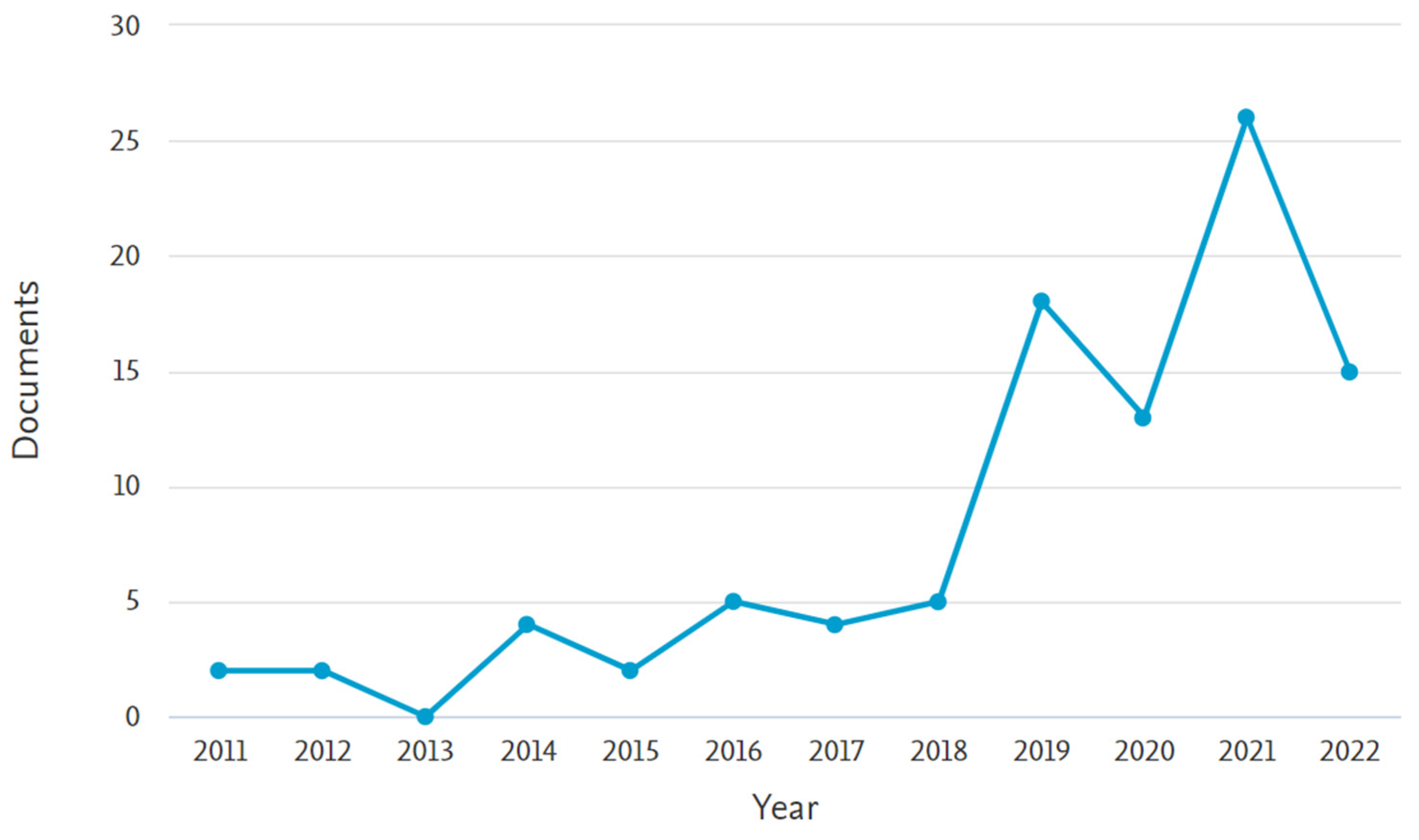
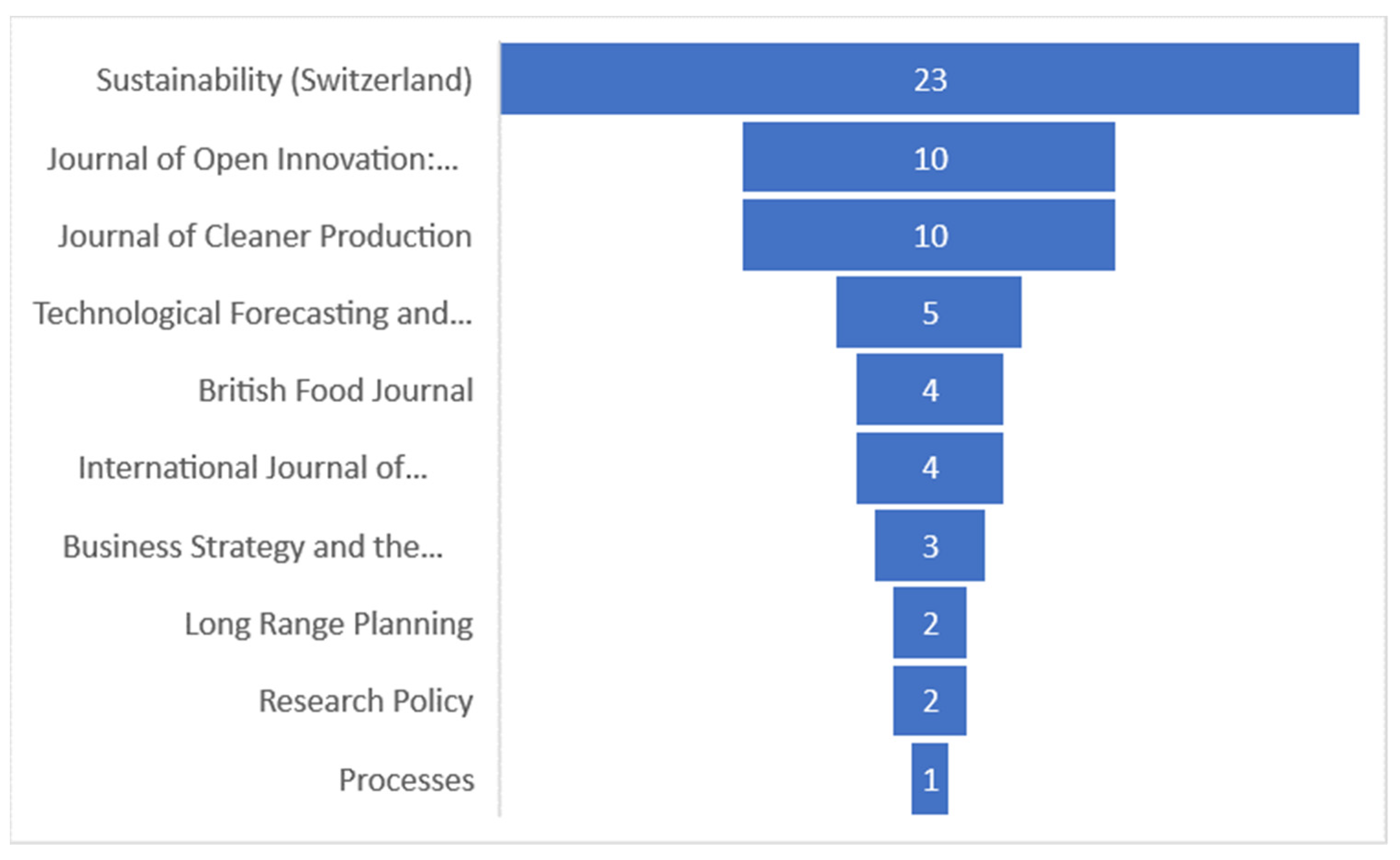
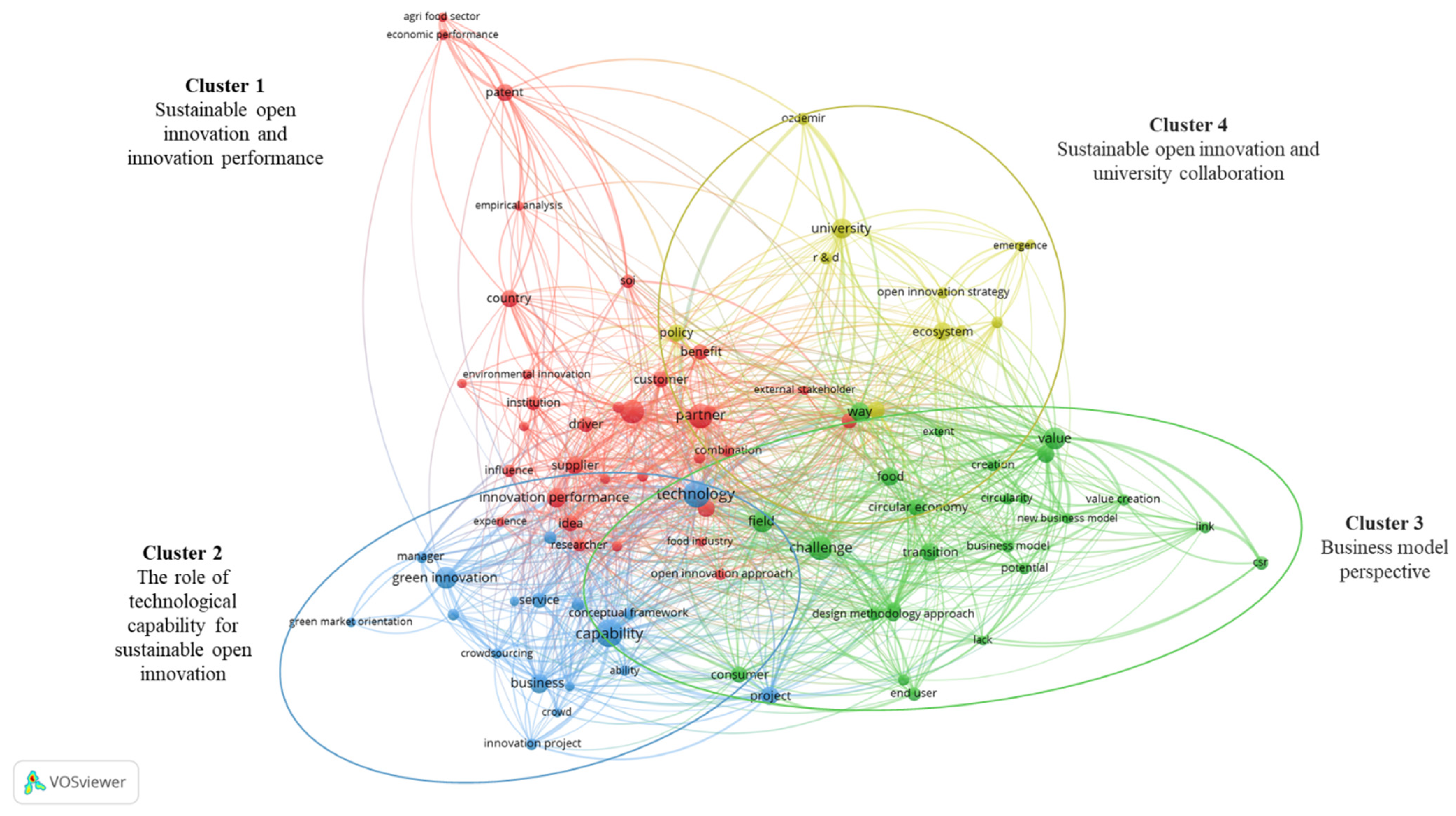
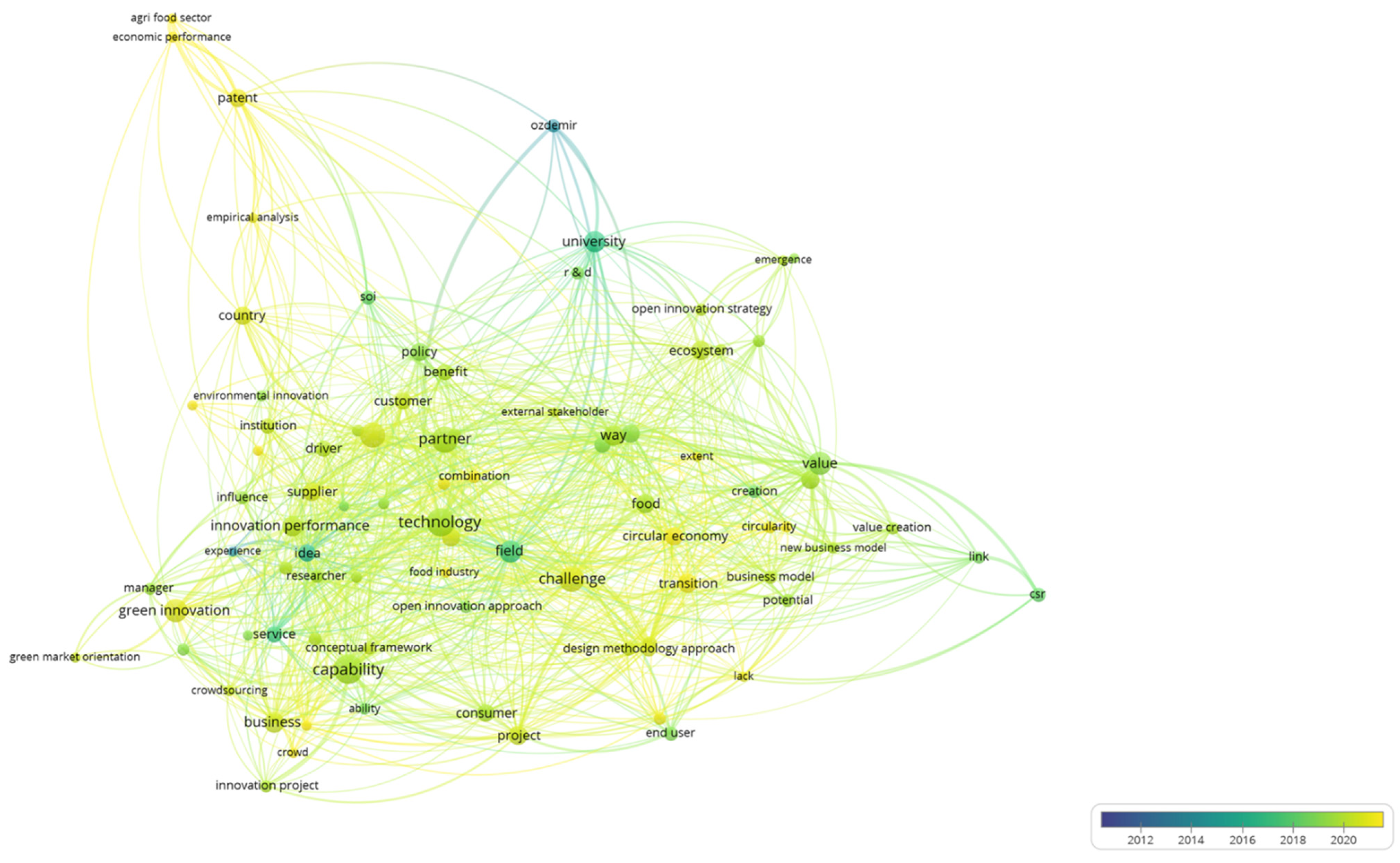
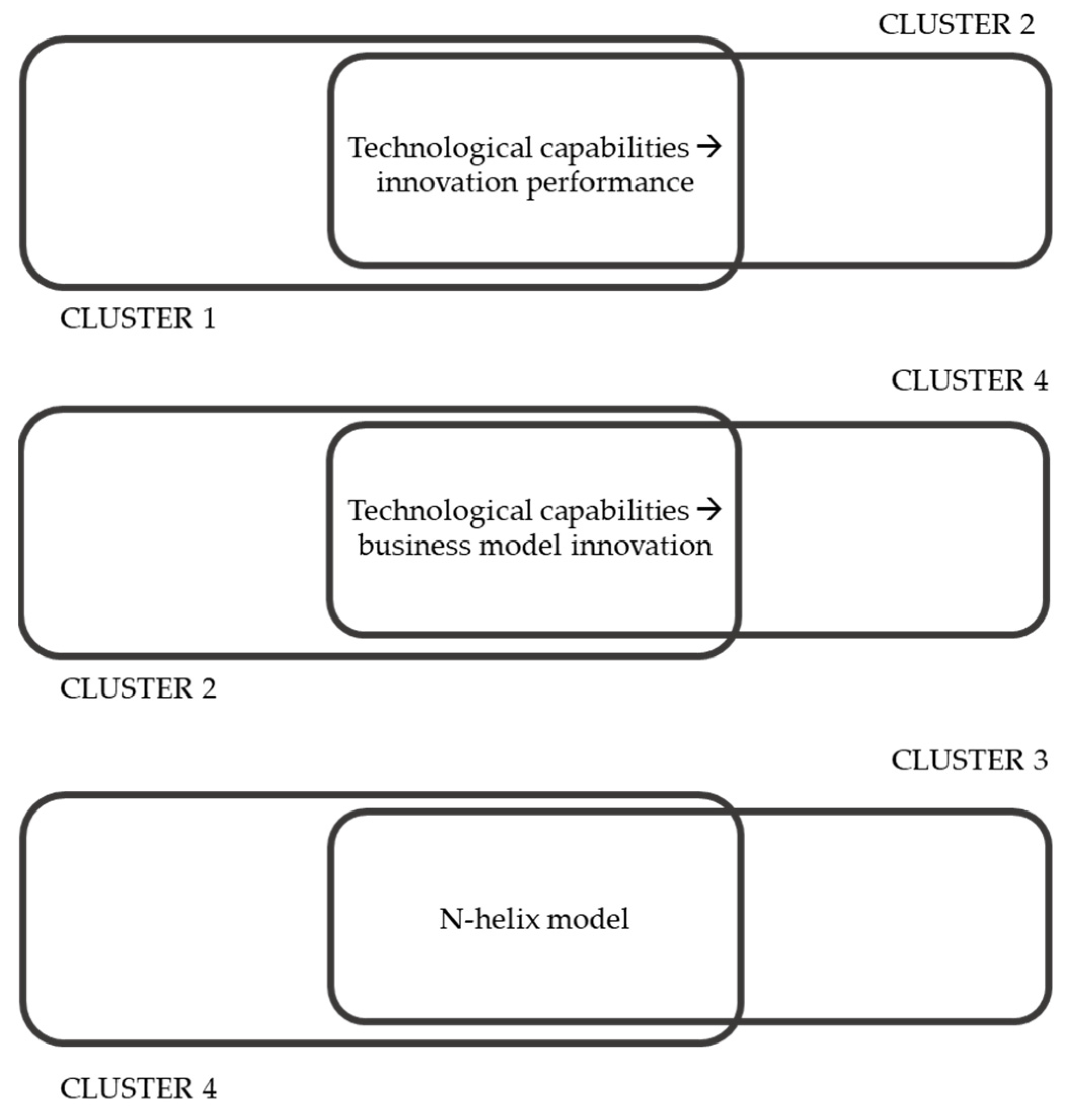
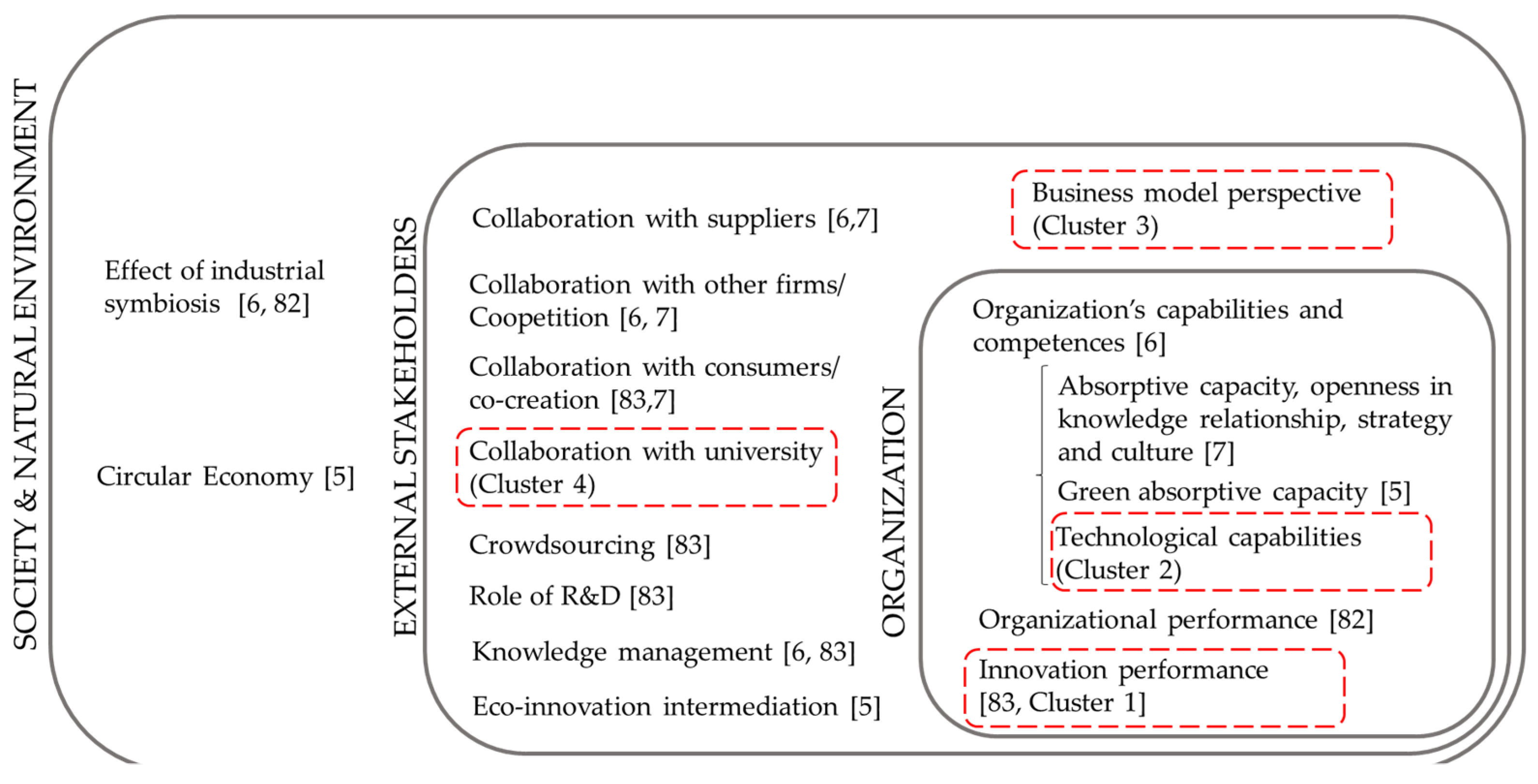
| Sustainability-Related Keywords | Open Innovation-Related Keywords | Combination of Sustainability and OI |
|---|---|---|
| “Sustainab *”, “green innova *”, “environemental innova *”, “eco * innova *”,”green product innova *”, “green process innova *”, “circular economy”, “circular strateg *” | “open innova *” | “open eco-innova *”, “open eco innova *”, “sustainable open innova *”, “open sustainable innova *”, “open environmental innovation”, “open eco-innovation mode”, “open eco innovation mode”, “Open-corporate greening”, “Open corporate greening”, “open innovation” |
| Author | N. of Papers |
|---|---|
| Baccarne, B. | 2 |
| Baumgartner, R.J. | 2 |
| Behnam, S. | 2 |
| Bocken, N. | 2 |
| Bogers, M. | 2 |
| Cagliano, R. | 2 |
| Cappa, F. | 2 |
| Costa, J. | 2 |
| Fabrizi, A. | 2 |
| Füller, J. | 2 |
| Country | N. of Papers |
|---|---|
| Italy | 21 |
| Spain | 10 |
| UK | 9 |
| US | 8 |
| Denmark | 7 |
| Austria | 6 |
| Brazil | 6 |
| China | 6 |
| Germany | 6 |
| Netherlands | 6 |
| Underpinning Theory | Reference |
|---|---|
| Resource-based view | e.g., [32,33,34] |
| Knowledge-based view | e.g., [35,36,37] |
| Organisational learning theory | e.g., [38,39] |
| Stakeholders’ theory | e.g., [40] |
| Dynamic capabilities theory | e.g., [5,41] |
| Theory of planned behaviour | e.g., [42,43] |
| Absorptive capacity theory | e.g., [44,45] |
| Avg Publication Year | Total Link Strength | Occurrences | Links | |
|---|---|---|---|---|
| Economic performance | 2021 | 83 | 6 | 11 |
| Agri-food sector | 2022 | 75 | 5 | 6 |
| Crowd | 2021 | 57 | 5 | 19 |
| Combination | 2021 | 99 | 7 | 34 |
| Circularity | 2021 | 85 | 7 | 18 |
| Food industry | 2021 | 40 | 5 | 19 |
| Eco innovation performance | 2021 | 55 | 5 | 8 |
| Green innovation behavior | 2021 | 135 | 5 | 13 |
| Enterprise sustainable innovation | 2021 | 30 | 5 | 6 |
| Circular business model | 2021 | 80 | 6 | 14 |
| Reference | Year | Scope | Methodology | Study Type | Time Span | N. of Articles | Main Results |
|---|---|---|---|---|---|---|---|
| [9] | 2016 | sustainable end-user innovation | Systematic literature review | qualitative | 1992–2015 | 84 | Identifies two strands of research: policies that provide end-users with resources to innovate; policies that facilitate the integration of end-users knowledge into an existing framework. |
| [6] | 2021 | open eco-innovation | Systematic literature review and bibliometric analysis | quantitative and qualitative | 1990–2020 | 538 | Proposes an unambiguous definition of open eco-innovation and identifies the main clusters of topics, differentiating them by level of analysis (micro, meso, and macro) |
| [5] | 2022 | open eco-innovation | systematic review and bibliometric analysis | qualitative and quantitative | 1999–2021 | 288 | Highlights developments over time in research regarding open eco-innovation and analyzes the knowledge base of open eco-innovation based on the type of external knowledge source. The emerging themes found are: green absorptive capacity, circular economy and eco-innovation intermediation. |
| [8] | 2021 | sustainable open innovation in the agri-food sector | systematic literature review and bibliometric analysis | qualitative and quantitative | 1995–2021 | 198 | Proposes a new definition of healthy food using the sustainable open innovation approach that combines technology, innovation and sustainability. |
| [82] | 2021 | Open innovation and Circular Economy | systematic literature review | qualitative | 2016–2020 | 24 | Examines the role of open innovation in the adoption of the circular economy, with a specific focus on organizational theories, factors to overcome CE implementation barriers and OI application at meso and macro levels of CE. |
| [83] | 2021 | Open innovation for sustainability | bibliometric analysis | quantitative | 2003–2019 | 3087 | Identifies the main issues discussed in the literature regarding the integration of open innovation and sustainability: collaboration for product development, knowledge management, R&D, firm network. |
| [7] | 2017 | Open innovation for Sustainable innovation | literature review | qualitative | 2003–2015 | 19 | Identifies the key stakeholders involved in the innovation process, both internally and externally to the company. |
Publisher’s Note: MDPI stays neutral with regard to jurisdictional claims in published maps and institutional affiliations. |
© 2022 by the authors. Licensee MDPI, Basel, Switzerland. This article is an open access article distributed under the terms and conditions of the Creative Commons Attribution (CC BY) license (https://creativecommons.org/licenses/by/4.0/).
Share and Cite
Bigliardi, B.; Filippelli, S. Sustainability and Open Innovation: Main Themes and Research Trajectories. Sustainability 2022, 14, 6763. https://doi.org/10.3390/su14116763
Bigliardi B, Filippelli S. Sustainability and Open Innovation: Main Themes and Research Trajectories. Sustainability. 2022; 14(11):6763. https://doi.org/10.3390/su14116763
Chicago/Turabian StyleBigliardi, Barbara, and Serena Filippelli. 2022. "Sustainability and Open Innovation: Main Themes and Research Trajectories" Sustainability 14, no. 11: 6763. https://doi.org/10.3390/su14116763
APA StyleBigliardi, B., & Filippelli, S. (2022). Sustainability and Open Innovation: Main Themes and Research Trajectories. Sustainability, 14(11), 6763. https://doi.org/10.3390/su14116763







